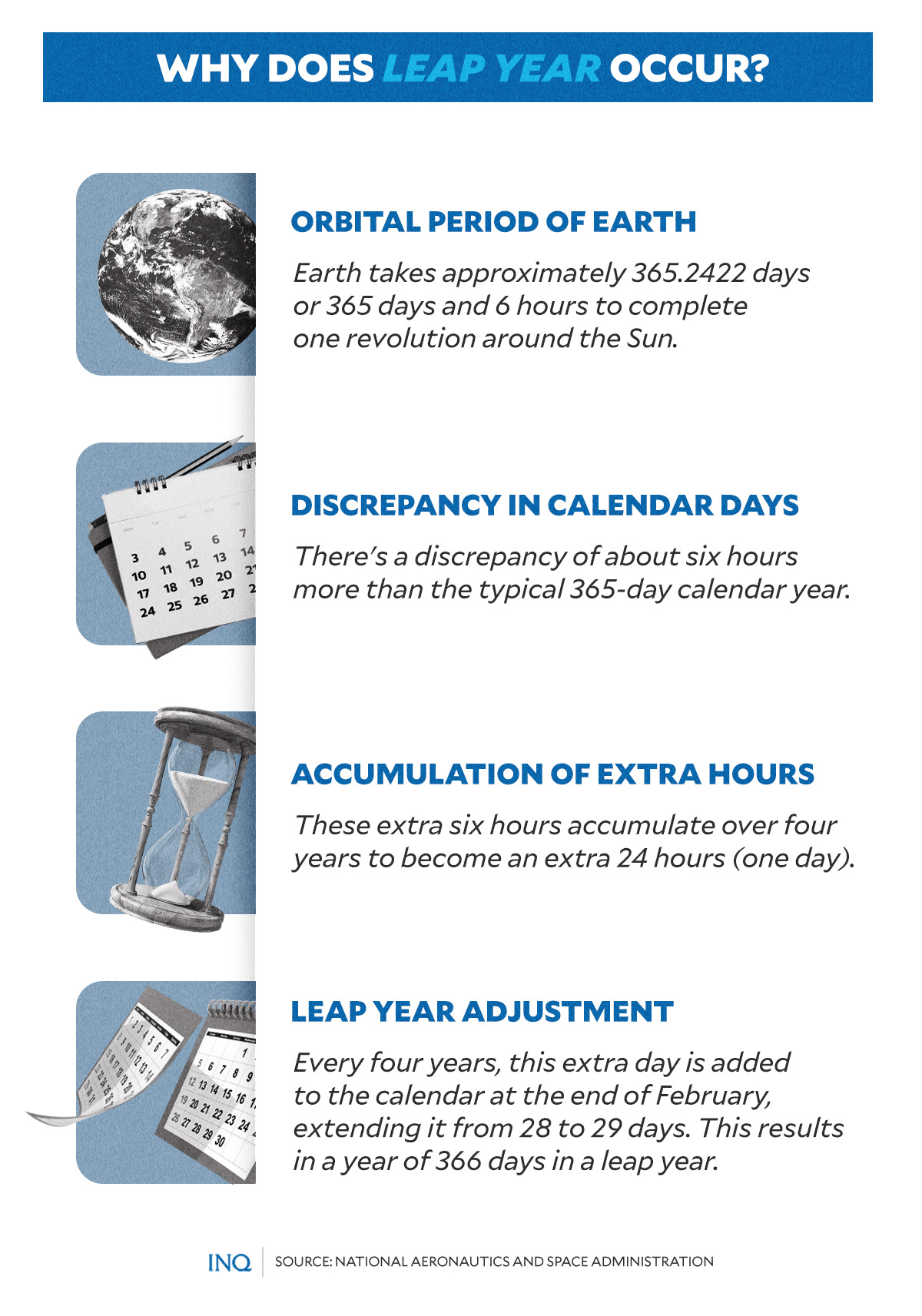Decoding Leap Year: The science, superstitions behind an extra day
MANILA, Philippines—In a remarkable display of astronomical timing, Leap Year emerges on our calendars every four years, offering an extra day, bringing a day laden with intrigue and historical depth.
This year serves as a perfect example, unfolding a unique blend of time-honored traditions and unexpected events.
From the rare alignment of significant global events to the tapestry of superstitions and traditions that leap across cultures, this quadrennial curiosity both synchronizes our clocks and stirs imaginations worldwide.
What is Leap Year?
Approximately every four years, February has 29 days instead of the usual 28, which means there are 366 days in that year instead of the 365 days we are used to. This is called a Leap Year.
But what brings this extra day during a Leap Year?
According to Lyle Tavernier, an educational technology specialist at the National Aeronautics and Space Administration’s (NASA) Jet Propulsion Laboratory, Leap Day — another name for Feb. 29 or the extra day that month — can be explained by how long it takes the Earth to revolve around the sun.
“The length of a year is based on how long it takes a planet to revolve around the Sun. Earth takes about 365.2422 days to make one revolution around the Sun,” Tavernier wrote.
“That’s about six hours longer than the 365 days we typically include in a calendar year,” he added.
As a result, to align our calendar with the Earth’s orbit, an extra day is added every four years at the end of February, known as Leap Day, accounting for the nearly 24 hours accumulated over that period.
Calendar adjustments
Before the Roman emperor Julius Caesar’s reign, a 355-day calendar was used, supplemented by an additional 22-day month every two years. However, due to its complexity, this system caused feast days to shift into different seasons.
To resolve the issue, Caesar had his astronomer, Sosigenes, devise a simpler method. Sosigenes then established a 365-day year with an added day every four years to account for accumulated hours, thus leading to February 29.
Moreover, according to NASA and National Geographic, although every fourth year is generally a Leap Year, Pope Gregory XIII refined the calendar in 1582. He stipulated that a Leap Year must be divisible by four, but century years require divisibility by 400 to qualify as Leap Years.
As a result, 2000 and 2400 are Leap Years, but 2100, 2200, and 2300 will not be.
Excluding the current year of 2024, the latest Leap Year was in 2020, with the next ones set to be in 2028 and 2032.
Did you know?
Despite the rarity of Leap Years, February 29th has witnessed its share of significant events in history, including the following:
- The first warrants of arrest in the Salem witch trials were issued on February 29, 1692.
- On February 29, 1940, actress Hattie McDaniel became the first African-American woman to win an Oscar for her role in Gone With the Wind.
- Former Philippine President Elpidio Quirino died of a heart attack at his home in Quezon City on the evening of February 29, 1956.
- British astronomer Dr. Jocely Bell Burnell announced the discovery of the first pulsar (a star that beams radio waves across the cosmos) in 1986.
Traditions, superstitions
Accompanying the various rules of Leap Year are longstanding superstitions that have whittled down from years of fear of going against the norm.
Below are some of the most outlandish myths and rumors that resurface roughly every four years, according to the British Broadcasting Corporation (BBC) and travel and lifestyle website Oddities and Curiosities Travel:
- Leap Day Proposals: There is a unique tradition where women are traditionally allowed to propose to men during Leap Day. Legend has it that this practice started with St. Brigid and St. Patrick in response to concerns from single women about the long wait for marriage proposals. This unique exception to conventional courtship customs is celebrated every Leap Year.
- Fines for refusing proposal: In 1288, Queen Margaret of Scotland allegedly introduced a law compelling men who declined a proposal to pay a fine or offer a gift. The origin of this tale is murky, as Queen Margaret would have been only five years old at the time, and there’s no historical evidence of such a law.
In Denmark, a quirky tradition holds that if a man turns down a woman’s Leap Year proposal, he must pay a peculiar fine: providing the woman with 12 gloves.
- ‘Prayers of Blessing’: There is a special prayer composed by a female clergy member for those planning a marriage proposal on a Leap Day. Intended for use on February 29th, this prayer seeks divine blessings for the couple planning to get engaged. It also serves as a gentle reminder that while wedding preparations are important, they should not overshadow the journey of building a life together.
The prayer is said to have been sourced from “Pocket Prayers of Blessing” by the Venerable Jan McFarlane, Archdeacon of Norwich.
- Not a great time for marriage nor divorce: While many traditions and beliefs around the world focus on marriage proposals during Leap Day, in Greece, it’s commonly believed that tying the knot in a Leap Year is unlucky, and such marriages are often thought to end in divorce.
Additionally, a Greek superstition suggests that if a couple divorces in a Leap Year, they are doomed to never find happiness again.
- Once every four years: La Bougie du Sapeur, a humorous French newspaper that debuted in 1980, holds the record for the least frequent publication schedule, issuing only once every four years.
The newspaper’s name, translating to “Sapper’s Candle,” is derived from a comic book character in France who was born on Leap Day. Copies sell for 4.80 euros (around P291.50) per issue, and each Leap Day, the paper enjoys considerable popularity, selling about 150,000 copies.
- Extremely unlucky: In Scotland, there’s a belief that those born on Leap Day — also called “leaplings” — are destined for a life of hardship. This superstition also extends to agriculture, with farmers particularly concerned about their livestock during Leap Years, as evidenced by the saying, “Leap Year was never a good sheep year.”
- Extremely lucky: Unlike the Scottish belief, others view being born on Leap Day as extremely fortunate, considering the rarity of a Leap Day birth — one in 1,461. Astrologers often associate those born under the Pisces sign, which includes Leap Day, with talents and good looks.
Historically, astrologers have seen children born on Leap Day as having unique talents and personalities. Among the well-known leaplings include rapper Ja Rule, Hollywood actors Antonio Sabàto Jr., Peter Scanavino, Alex Rocco, and the celebrated jazz musician Jimmy Dorsey.
- Ominous day: In Russia, leap years are associated with an increased chance of unusual weather and a higher risk of death. Additionally, a common superstition suggests that Leap Years bring more deaths.
While Leap Year superstitions aren’t grounded in science, some might argue that indulging in these myths can be enjoyable and innocuous.
However, it’s important to be mindful that these beliefs should not immobilize you with fear or prevent you from seizing life’s moments, particularly given their vague origins. This is especially pertinent as Leap Year occurs only once every four years, making each one unique.



